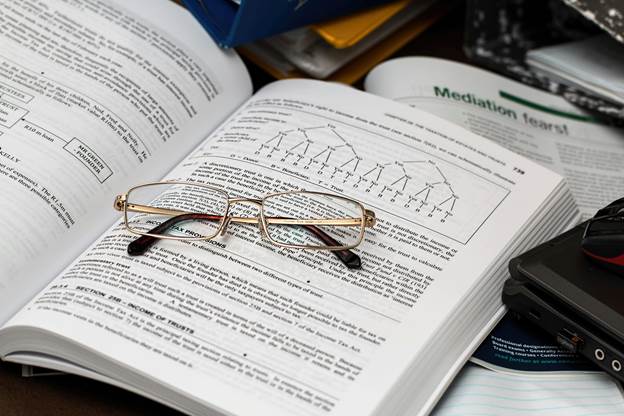The Hidden Power of References
Writing an essay, term paper or dissertation is more than presenting your argument in a logical fashion. It requires focused research, analysis of theories, a critique of these ideas, and coming up with a unique position on the topic in question. To achieve this, you are required to support your ideas with credible evidence that justifies your final conclusion.

Most students know they need evidence to support their arguments. However, many do not understand how much references influence their final score and academic success.
All scholarly works are evaluated on the strength of their arguments, unique position, and how they use available references to support such arguments. Whether it is an undergraduate essay, Masters level paper, or a PhD dissertation – references are instrumental in showing your research skills, engagement with current research, and effective application of existing ideas to build on your own work.
References can be the deciding factor on whether your essay fails or receives a passing grade. As such, understanding how to apply credible sources (references) to your work is an essential skill that any student should master.
However, there are many questions students struggle to understand in regards to the use of references. For example, how many references do you need for a 2,500-word essay? How do you include in-text references in your work and organize them in your bibliography? Can you use different reference styles in one paper?
Let’s unpack everything as we explore how you can use credible sources in the correct format to improve your grades.
References Matter More Than You Think
References are the backbone of academic integrity. Any credible research work must include peer-reviewed sources to justify its relevance in practice, its value proposition, and the concluding remarks on the solution it suggests. Your work must build on established research. It is academic tradition, a valid ground to justify new ideas on shaping perspective and policy on issues that are important to human existence or such other reason. References legitimize your research – a fact that will earn you top grades in your assignments.
In addition, references;
- Demonstrate your depth of research and honesty in your work.
- Prevent against plagiarism claims that may damage your final submission.
- Prove that you indeed conducted research by consulting credible, peer-reviewed sources.
- Help develop critical, independent thinking through analysis of source, comparison, and contrast of various ideas.
A student who integrates credible peer-reviewed evidence or other sources demonstrates their grasp of concepts, theories, and substance of what they are exploring.
The next question then becomes; How Many References Do You Need for a 2,500-Word Essay?
 There’s no accepted number of references for any number of words of research. The common practice is that each rubric specifies the number of references that should be used for such paper. However, the general practice is described below;
There’s no accepted number of references for any number of words of research. The common practice is that each rubric specifies the number of references that should be used for such paper. However, the general practice is described below;
|
Essay Length
|
Suggested Number of References
|
|
1,000 words
|
5–8 references
|
|
2,500 words
|
10–15 references
|
|
5,000 words
|
20–25 references
|
|
Dissertation (10,000+ words)
|
50+ references
|
Take note that quality matters more than quantity. Your 2,000-word research could have 20 irrelevant sources which will only lead to more confusion of the ideas you are trying to present. On the other hand, you could cite five highly relevant, peer-reviewed journal articles that strengthen your argument — and outperform a paper with randomly selected sources that are outdated and irrelevant.
For example, if your essay argues that “CRISPR is a harmful technology for future medical interventions,” you don’t need 30 citations from Wikipedia or random blogs. You need 7-10 authoritative academic articles, or government reports to support your argument. You need balance, credibility, and relevance.
Choosing the Right (Credible and relevant) Sources
Research is a continuous process that builds your thesis into a finished paper. The research you conduct should rely on credible sources. A credible source is one that reliable and trustworthy – providing accurate and objective insight into the topic you are exploring. As such, a credible source is one whose author is an expert in the subject, is published in a reputable publication, and uses an evidence-based approach in its analysis of ideas in the paper. It is never biased and reflects on the current state of practice.
It is important that you choose a source from within the last five years. A credible source should be peer-reviewed (google!). Peer-reviewed sources are preferred as they have been critiqued by industry experts in the specific field they are sourced from. Don’t include anything you find on the first page of google as most of those are keyword-based rankings that may have nothing to do with what you are writing about. Be careful and keen!
Your best options are;
- Published books by renowned scholars and publishing houses
- Primary data from reputable organizations e.g. the UN, WHO, or the OECD
- Government or institutional reports
- Peer-reviewed academic journals such as ScienceDirect, PubMed, SSRN, or JSTOR
? Avoid sources from Wikipedia, random blogs, or opinion pieces from chat forums such as Quora or Reddit. They are not verified and may be misleading to say the least.
A credible source has a verified author, has undergone peer-review by scholars in the same niche, and have a recent date of publication.

You can get expert guidance from our Top Tutors. They have been in the academic writing field for years so you are in safe hands. They help you filter through thousands of online sources and narrow down to only those that are relevant for your research.
In-Text Referencing and Bibliography Basics
Every idea you borrow from another person must be attributed. It might be a simple idea, a quote, or data metric – the source must be acknowledged using in-text referencing. These attributions must also feature in the reference list at the end of your paper.
The more common referencing styles are;
|
Style
|
Region/Field
|
In-text Example
|
Reference List Example
|
|
APA (7th Ed.)
|
US, Psychology, Business
|
(Smith, 2022)
|
Smith, J. (2022). AI and Learning. Oxford Press.
|
|
Harvard
|
UK, General
|
(Smith, 2022)
|
Smith, J. (2022) AI and Learning. Oxford: Oxford Press.
|
|
MLA
|
Humanities
|
(Smith 22)
|
Smith, John. AI and Learning. Oxford UP, 2022.
|
|
Chicago
|
History, Law
|
(Smith 2022, 34)
|
Smith, John. AI and Learning. Oxford: Oxford Press, 2022.
|
All your references should be uniform – do not mix different reference styles in one paper.
When creating your bibliography or reference list, there are different tools that can help you such as Grammarly’s citation manager and bibtext. When properly done, references reduce instances where you are accused of plagiarism.
Good practice demands that you provide justification and citation of whatever information you are presenting. If you can’t cite it, then you shouldn’t have it.
It is no secret that proper referencing contributes to about 10 to 20 percent of your marks. It shows you as a proper researcher, and carry independent thought processes. It is what makes the difference for an outstanding essay.
You don’t have to worry if you struggle with referencing and how to include them in your papers. Indeed, there are different citation formats, reference lists, and getting credible sources can be time-consuming. That’s why our experts are always available to help you;
- Help you identify the right peer-reviewed sources
- Guide you in using proper citation tools
- Review your reference list for consistency
- Teach you how to write an A+ essay that meets academic standards
So, the next time you are faced with a 2,500-word essay, remember that references ensure to solidify your arguments and get that passing grade. They ensure accuracy, confidence, and originality for your work. Don’t hesitate to reach us on our website to get the best guides to take through your scholarly journey!
